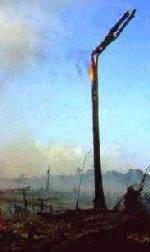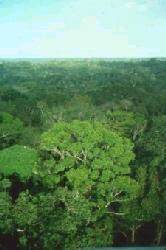|
|
|









![]()
Amazon Forest Loss Double That Reported
WOODS HOLE, Massachusetts, April 9, 1999 (ENS) - The Amazon forests of Brazil are vanishing at more than twice the rate reported by Brazilian authorities, according to a new study by Woods Hole Research Center scientist Dr. Daniel Nepstad. The official reports do not include forests lost to fires and logging, which account for more than half the total forest area destroyed each year, Dr. Nepstad said. One-third of the world's moist tropical forests are found in Brazilian Amazonia.
Dr. Daniel Nepstad surveys fire damage in the Brazilian Amazon (Photos courtesy Woods Hole Research Center)
"The situation is bad, much worse than official data would have us believe," Dr. Nepstad told ENS in an interview.
In an article published in the current issue of "Nature," the research team led by Dr. Nepstad wrote, "Our field studies of wood mills and forest burning across Brazilian Amazonia show that logging crews severely damage 10,000 to 15,000 square kilometres a year of forest that are not included in deforestation mapping programs, while surface fires burn additional large areas of standing forest."
The official reports do cover forested lands converted for agricultural use, but ignore areas of forest alterations that reduce tree cover, but do not eliminate it, such as logging and surface fires in standing forests.
During years of severe drought, the amount of unreported forest destroyed is even greater, the study found. "This is something we've known for quite a while, but we've never been able to get anyone to believe us," Dr. Nepstad said.
The official reports from Brazil acknowledge they do not cover logging and fire, he said. "It took the big fires of 1998 that we correctly predicted in 1997 to get their attention."
Dr. Nepstad's study estimated the area of Brazilian Amazon forest that is "impoverished" each year through logging by interviewing 1,393 wood mill operators, representing more than half of the mills located in 75 logging centers. These logging centers are responsible for 90 percent of Amazonian timber production.

The area of standing forest subjected to surface fire each year was assessed by
interviewing 202 landholders in five regions along a 2,200-km transect through
the states of Pará, Mato Grosso, Rondônia and Acre. Their accounts were
checked against satellite images and researchers' observations. "The
landholders underestimated the area of surface fires by 43% and of deforestation
by half," the study found.
Brazil now has quite an ambitious program to predict where fire is going to take place based on a plan developed by the team Dr. Nepstad leads which includes IPAM (Instituto de Pesquisa Ambiental da Amazônia), a group based in Belem, Brazil. Brazilian government agencies as collaborated in creating the program.
"The Brazilian government prohibited burning in 1998 in high risk areas from our fire risk map," said Dr. Nepstad, "something we didn't recommend but they did on their own initiative."
"Right now it's illegal to carry logs on the highways of the Amazon," the Woods Hole scientist said with some satisfaction. "The Brazilian environment agency IBAMA is supposed to have a lot more power now to jail and fine people. We still haven't seen a big increase in that enforcement, but the loggers are worried. They have gone to Brasilia and met with ministers on this."
Dr. Nepstad said the solution to Amazonian deforestation is not in national level policies but in proposals coming up from the public with a broad political constituency. As an example, he points to a recent hearing before Brazil's national congress to present the results of a 1998 regional meeting in Belem organized by IPAM. There, the beginnings of public concern over the defense of the public good were evident.
The big research agencies of Brazil are really beginning to accept that credible science can be done by private scientific research organizations. The last year or two has been a remarkable advance, Dr. Nepstad said.
But there are still great financial gaps between funding needed to carry out research into Amazonian deforestation and restoration and the funds available.

Pristine Amazon rainforest
In order to
meet budget targets set with the International Monetary Fund, the Brazilian
government decided to refuse US$25 million of foreign donations for the
environmental area in 1999. This decision was taken in the context of cuts made
in environmental areas in the budget proposal sent by the President Fernando
Henrique Cardoso to the Congress.
The Program
for Expansion and Consolidation of Protected Areas in the Brazilian Amazon
Region, for instance, received a 100 percent cut. The Pilot Program for
Conservation of Brazil’s Rainforests was cut by 89.6 percent in spite of the
fact that 80 percent of the funds for this program come from donations by the
Group of Seven richest countries in the world, the G-7.
In addition,
funding for Amazon forest research has been disrupted by the mass resignation of
all 20 European Union Commissioners last month over a report accusing six of
them of mismanagement.
IPAM was
promised a 1.4 million grant from the European Union to begin a year ago that
Dr. Nepstad says has been held up by the Commissioners' resignation. And three
IPAM funding proposals to the Pilot Program for Conservation of Brazil’s
Rainforests have not been moved forward.
But in spite
of the Woods Hole team's insecure financial situation, some funding has been
found to continue.
Detailed
studies are important to understanding what is occuring on the ground.
"Human uses of tropical forests vary greatly in their ecological
impacts," the Woods Hole report states. "Ranchers and farmers
'deforest' land in preparation for cattle pasture and crops by clear-cutting and
burning patches of forest. Loggers do not clear-cut and burn, but perforate
forests by harvesting or damaging many trees."
"Rubber
tappers and other extractivists use the forest at very low intensity through the
harvest of animals, fruits, latex and other "non-timber products." The
first use, known as deforestation, has a greater impact on forest carbon
content, forest hydrology, and the diversity of native plant and animal species
than other forest uses and has become the main parameter by which human effects
on tropical forests are measured," the report states.
Part of the
appeal of this forest vs. non-forest approach to assessing human impacts on
tropical forests is its tractability, the study says. "Forest conversion to
agriculture is readily monitored from space using imagery from the Landsat
Thematic Mapper satellites, permitting the development of deforestation maps of
large regions at a reasonable cost and speed."
But this
method does not tell the whole story. In fact, as Dr. Nepstad's studies show,
this method tells less than half of the story.
© 1999.
All Rights Reserved.